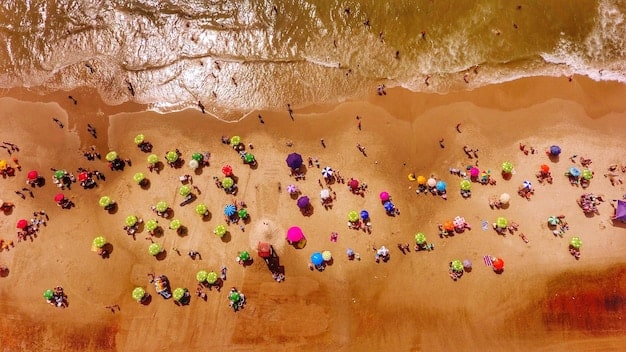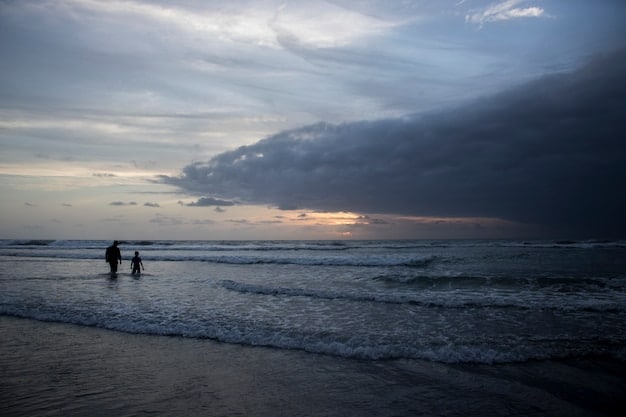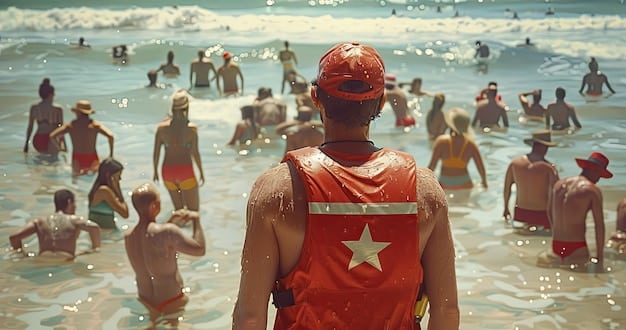7 Overlooked Beach Safety Tips for 2025 That Could Save Your Life

To enhance beach safety in 2025, prioritizing less common yet critical tips beyond basic swimming precautions is essential; these include understanding rip currents, recognizing marine life dangers, monitoring weather systems, practicing sun protection, staying hydrated, knowing local emergency procedures, and avoiding alcohol, all of which significantly reduce risks and potentially save lives.
As the allure of sunny shores beckons, many of us dream of tranquil waves and golden sands. Yet, beneath the pristine beauty, beaches harbor potential dangers that demand respect and awareness. While common advice like swimming between flags is widely known, there are an array of 7 Overlooked Beach Safety Tips That Could Save Your Life in 2025, often ignored but crucially important.
Beyond the Flags: Understanding Rip Currents from Afar
The ocean’s power extends far beyond what meets the eye, and rip currents are perhaps its most deceptive and dangerous manifestation. These narrow, powerful channels of water flow quickly away from shore, dragging even strong swimmers out to sea. Many beachgoers mistakenly believe they can identify a rip current easily or that they only occur in rough conditions, a misconception that proves fatal too often.
Identifying a rip current doesn’t always require seeing a distinct channel of water churning. Sometimes, it’s a subtle visual cue that indicates a hazard. Learning to spot these signs from the beach before entering the water can be a life-saving skill.
Visual Cues for Identifying Rip Currents
Before you even dip a toe in the water, take a moment to observe the ocean’s surface. Look for breaks in the incoming wave pattern or areas where debris and foamy, discolored water are being carried out to sea. These are classic indicators of a rip current’s presence. Understanding these visual signals is paramount.
- Gap in the waves: Rip currents often create a gap in the line of incoming waves, as the outgoing current flattens them.
- Discolored water: Sediment and sand stirred up by the current can make the water appear muddier or cloudier than the surrounding areas.
- Foam or debris moving seaward: If you see a line of foam, seaweed, or other floating objects moving steadily away from shore, it’s likely a rip current.
It’s crucial to remember that rips can be powerful enough to carry anyone, regardless of their swimming ability, out to deeper waters quickly. Panicking and trying to swim directly against the current are common reactions, but these only lead to exhaustion. Instead, if caught, conserve energy and swim parallel to the shore to escape the narrow channel, then swim back to land.
Always check local beach conditions and weather forecasts before heading out. Many beach apps and websites provide real-time information on rip current risks, lifeguard presence, and ocean conditions. Arm yourself with this knowledge, and you’re already one step ahead in safeguarding your beach experience.
The Untamed Wilderness: Recognizing Marine Life Dangers
Beaches are not just for humans; they are vibrant ecosystems teeming with diverse marine life. While most creatures are harmless, some pose significant risks if encountered unprepared. Beyond the well-known shark fear, less obvious threats like jellyfish, stingrays, and sea urchins can turn a relaxing day into a painful emergency. Understanding the local marine inhabitants and how to react to them is a vital, yet frequently overlooked, safety measure.
The vast majority of beach-related injuries involving marine life are preventable with proper caution and awareness. It’s not about avoiding the ocean, but rather interacting with it respectfully and knowledgeably. Education on identifying common dangerous species and knowing basic first aid for bites or stings can greatly mitigate risks. Always remember that marine life should be observed from a distance and never provoked.
Common Marine Dangers and Prevention
Different coastal regions harbor different marine risks. Before visiting a new beach, a quick search for local marine hazards can equip you with crucial information. For instance, in some areas, jellyfish blooms are seasonal occurrences, while in others, encounters with stingrays are more common in shallow, sandy waters.
- Jellyfish: Look for warning signs and avoid swimming when blooms are present. If stung, rinse with saltwater (not fresh) and apply vinegar or heat.
- Stingrays: Shuffle your feet when walking in shallow sandy areas to scare them away, preventing accidental stings.
- Sea Urchins: Wear water shoes in rocky areas. If punctured, carefully remove spines and seek medical attention if symptoms worsen.
Beyond these, be aware of natural camouflage that can make some creatures, like stonefish, almost invisible. Touching coral reefs can also lead to cuts and infections due to bacteria. The ocean is a powerful and complex environment, and respecting its inhabitants is a fundamental part of staying safe. Always carry a basic first aid kit, and if encountering a serious marine injury, seek immediate medical assistance.
Decoding the Skies: Monitoring Weather Systems and Tides
A clear sky can quickly turn ominous at the coast. Weather patterns over oceans are notoriously fickle, changing rapidly and often unexpectedly. Many beachgoers focus solely on today’s forecast, overlooking the potential for sudden shifts in wind, surf, and electrical storms. Understanding how to interpret weather signals, both official and natural, along with how to read tide charts, is paramount for beach safety in 2025.
Ignoring weather warnings or failing to consult tide tables can lead to dangerous situations, from being caught in a sudden squall to getting stranded by an incoming tide. Always refer to reliable weather sources and local tide charts, especially if exploring unfrequented coves or tidal pools. The ocean’s power is always greater than perceived.

Crucial Weather and Tide Considerations
Modern technology offers myriad ways to stay informed. Weather apps designed for marine conditions provide real-time updates on wind speed, wave height, and potential storm formations. Learning to correlate these digital forecasts with natural observations, such as changes in cloud patterns or wind direction, can provide an extra layer of preparedness.
- Sudden Storms: Always check marine weather forecasts before and during your beach day. Look for darkening skies, sudden drops in temperature, or increased wind as signs of impending storms.
- Lightning Safety: If you hear thunder, lightning is close enough to strike. Seek shelter immediately, ideally indoors or in a hard-topped vehicle. No place outdoors is safe during a thunderstorm.
- Tidal Awareness: Consult local tide charts, particularly if exploring shorelines with cliffs or inlets. Incoming tides can quickly cut off escape routes, trapping unaware individuals.
Always pack an emergency kit with essentials like a fully charged phone, a portable charger, water, and appropriate clothing. If conditions deteriorate, err on the side of caution and leave the beach. A day of enjoyment should never come at the expense of safety, and understanding the environment is key to making wise decisions.
The Unseen Assailant: Prioritizing Advanced Sun Protection
The sun’s rays are an undeniable attraction of the beach, yet they are also one of its most insidious dangers. Beyond immediate sunburn, prolonged and unprotected sun exposure contributes to premature skin aging, immune system suppression, and a significantly increased risk of skin cancer. Many diligent beachgoers focus solely on applying SPF, but advanced sun protection in 2025 involves a multi-faceted approach that goes far beyond a simple lotion.
The cumulative effects of sun exposure are often underestimated, leading many to dismiss the long-term health implications. Skin cancer, including melanoma, is a serious and potentially deadly consequence of neglecting comprehensive sun protection. It is crucial to adopt practices that shield you effectively from both UVA and UVB rays throughout your beach visit.
Comprehensive Sun Shielding Strategies
Effective sun protection is about creating a physical barrier and managing exposure times, not just relying on a single product. Sunscreen is essential, but it’s most effective when part of a broader strategy that includes seeking shade, wearing protective clothing, and avoiding peak UV hours.
- Reapply Sunscreen Religiously: Apply broad-spectrum sunscreen (SPF 30 or higher) at least 20 minutes before sun exposure, and reapply every two hours, or more often if swimming or sweating. Don’t forget often-missed spots like ears, neck, and feet.
- Seek Strategic Shade: Plan your beach day around the sun’s peak hours, typically between 10 AM and 4 PM. During these times, make use of umbrellas, canopies, or natural shade provided by trees.
- Wear UPF Clothing: Invest in clothing with a Ultraviolet Protection Factor (UPF) rating. These fabrics are specifically designed to block harmful UV rays and offer superior protection to regular clothing.
Consider wearing wide-brimmed hats and UV-blocking sunglasses to protect your face, neck, and eyes. Even on cloudy days, UV rays penetrate clouds, so consistent protection is vital. By adopting these advanced sun protection practices, you can significantly reduce your risk of skin damage and ensure a healthier, safer beach experience for years to come.
The Dehydration Deception: Staying Hydrated beyond Thirst
The combination of sun, heat, and activity at the beach makes dehydration a significant, yet frequently underestimated, threat. Many people wait until they feel thirsty to drink water, but by then, their body is already mildly dehydrated. In 2025, true beach safety emphasizes proactive hydration, understanding that adequate fluid intake is critical for overall health and preventing more serious conditions like heat exhaustion or heatstroke.
Dehydration can creep up unnoticed, impairing judgment, reducing physical performance, and making you more susceptible to heat-related illnesses. The body rapidly loses fluids through sweating in hot environments, and replenishing these fluids is crucial. This is especially true for children and the elderly, who are more vulnerable to dehydration.
Proactive Hydration for Optimal Beach Safety
Staying ahead of thirst is the golden rule for beach hydration. Don’t just bring one bottle of water; plan for continuous intake throughout your stay, especially if you’re active in the sun or water. Electrolyte-rich drinks can also be beneficial in very hot conditions or after intense physical activity.
- Start Hydrated: Drink plenty of water before you even arrive at the beach. Beginning your day well-hydrated sets a good foundation.
- Frequent Sips: Don’t chug large amounts of water all at once. Instead, take small, frequent sips throughout the day, even if you don’t feel thirsty.
- Avoid Dehydrating Beverages: While tempting, alcohol, sugary sodas, and excessive caffeine can actually contribute to dehydration. Opt for water, coconut water, or diluted fruit juices instead.
Pay attention to your body’s signals – dizziness, fatigue, and dark urine are all indicators of dehydration. Ensure children and older adults are also regularly drinking, as they may not communicate thirst as readily. A well-hydrated body is better equipped to handle the demands of a day at the beach, contributing significantly to your overall safety and enjoyment.
Local Knowledge is Power: Navigating Emergency Procedures and Beach Regulations
Every beach has its unique characteristics, regulations, and emergency protocols. Overlooking these local specifics can lead to confusion and danger when moments count. From knowing where the nearest lifeguard station is to understanding the warning flag system, and even the local marine life advisories, being informed about the particular beach you are visiting is a critical, yet often neglected, safety tip for 2025.
Assume that all beaches operate under the same rules is a dangerous oversight. Specific geological features, environmental conditions, and local ordinances vary widely. Taking the time to familiarize yourself with these details upon arrival can empower you to make safer decisions and respond effectively in an emergency. It’s about being a responsible visitor, not just a casual one.

Essential Local Information to Acquire
Upon arriving at any beach, make it a priority to locate information boards or speak with a local lifeguard. These sources provide invaluable intelligence that can safeguard your visit. This knowledge isn’t just for emergencies; it helps prevent potential rule infractions or environmental damage.
- Understand Warning Flags: Familiarize yourself with the local flag system, which indicates current water conditions, presence of dangerous marine life, or other hazards. Red often means high hazard, yellow means medium hazard, and green means low hazard.
- Locate Emergency Services: Know where the nearest lifeguard station, first aid post, or emergency call box is. In an emergency, every second counts.
- Review Local Regulations: Be aware of rules regarding bonfires, fishing zones, pet access, and prohibited activities to avoid fines and ensure safety for all beachgoers.
Beyond these, consider the accessibility of the beach for emergency vehicles. Some remote coves, while beautiful, can be challenging for rescue teams to reach quickly. Always have a fully charged phone and know the local emergency number. Being prepared with local knowledge enhances not only your safety but also your peace of mind.
The Hidden Impact: Avoiding Alcohol and Impaired Judgment
For many, a beach day is incomplete without a refreshing alcoholic beverage. However, the combination of alcohol, sun, and water can be a deadly cocktail. Alcohol impairs judgment, slows reaction times, and can lead to dangerous overconfidence in the water. Moreover, it accelerates dehydration, exacerbating the risks of heatstroke and other heat-related illnesses. This seemingly innocuous habit is one of the most overlooked, yet critical, beach safety tips for 2025.
Even moderate alcohol consumption can significantly heighten your risk of accidents, injuries, or drowning. The relaxed beach environment often leads people to underestimate these dangers. The statistics consistently show a correlation between alcohol use and water-related fatalities. Responsible beach behavior means prioritizing safety over temporary indulgence.
Serious Consequences of Alcohol at the Beach
The impacts of alcohol extend beyond just impaired swimming ability. It can affect your decision-making when it comes to sun exposure, marine life interactions, and even basic supervision of children. Understanding the full spectrum of these dangers is vital for preventing tragic incidents.
- Impaired Swimming Ability: Alcohol reduces coordination, balance, and the ability to gauge depth and distance, making swimming far more hazardous.
- Accelerated Dehydration: Alcohol acts as a diuretic, increasing fluid loss and significantly raising the risk of heat exhaustion or heatstroke when combined with sun and heat.
- Reduced Awareness of Surroundings: Under the influence, individuals are less likely to notice dangerous rip currents, marine life, changing weather, or signs of distress in others.
If you choose to drink, do so responsibly—away from the water and in moderation. Designate a sober person to be responsible for safety, especially if children are present. The ocean demands respect, and a clear mind is your best defense against its unpredictable nature. Prioritizing sobriety ensures a safer, more enjoyable experience for everyone at the beach.
| Key Safety Tip | Brief Description |
|---|---|
| 🌊 Know Rip Currents | Learn to identify and react to dangerous rip currents for safe swimming. |
| 🐠 Marine Life Awareness | Educate yourself on local marine hazards and first aid for stings/bites. |
| 🌤️ Monitor Weather & Tides | Check forecasts and tide charts to avoid sudden storms or getting stranded. |
| 🚫 Avoid Alcohol | Alcohol impairs judgment and accelerates dehydration, increasing risks. |
Frequently Asked Questions About Beach Safety
Immediate signs of a rip current include a gap in the incoming wave pattern, a channel of churning, choppy water, a line of foam, seaweed, or debris moving steadily seaward, and discolored water that extends beyond the surf zone. These visual cues indicate a strong, narrow current pulling water away from the shore, which can be extremely dangerous for swimmers.
To protect yourself from marine life, always shuffle your feet when walking in shallow, sandy areas to scare away stingrays. Wear water shoes in rocky or coral areas to prevent punctures from sea urchins or sharp shells. Avoid touching or provoking any marine animals, and pay attention to local warning signs about jellyfish or other hazardous creatures. Always observe marine life from a safe distance.
The most common mistake is relying solely on a single application of sunscreen at the start of the day. Effective sun protection requires reapplication every two hours, or more frequently if swimming or sweating. Many people also forget to protect often-missed areas like ears, neck, and feet, and they often underestimate the sun’s intensity on cloudy days, leading to unexpected burns and damage.
Staying hydrated is crucial because by the time you feel thirsty, your body is already starting to dehydrate. The sun, heat, and physical activity at the beach cause significant fluid loss through sweating. Proactive hydration helps prevent heat exhaustion, heatstroke, and maintains optimal body function, mental clarity, and energy levels. Waiting until you are thirsty puts you at a higher risk for serious health issues.
Absolutely. Local beach regulations are vital because they often address specific dangers or environmental sensitivities unique to that location. These rules cover everything from flag warnings indicating water conditions and marine hazards to restrictions on bonfires or pet access. Understanding them ensures your safety, helps protect the environment, and can prevent fines or other legal issues, contributing to a responsible and safe visit for all.
Conclusion
While the allure of the beach is undeniable, ensuring a safe and enjoyable experience requires more than just basic precautions. By adopting these 7 overlooked safety tips—from understanding rip currents and marine life to proactive hydration and adherence to local regulations—you empower yourself with knowledge that can genuinely save lives. The ocean’s beauty demands our respect and informed vigilance. Make these practices part of your beach ritual in 2025, transforming every visit into a journey of well-being and peace of mind.





